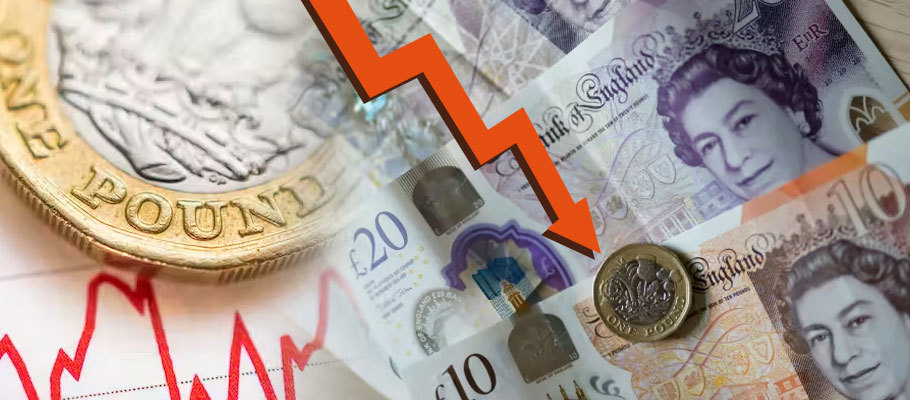
Published: September 21st, 2022
After a dismal performance over the last fortnight, analysts say Sterling is set to fall even further this week. A faint prospect of gains could materialize, however, following the Bank of England’s scheduled rate hike on Thursday and the Truss government’s first 'mini budget' is announced on Friday.
The fiscal and monetary double-whammy will arrive after a period that’s seen the Pound crater against the Dollar to levels not seen since 1985. Pitted against the Euro, Sterling is plumbing lows not seen since March of 2021.
Disappointing UK retail sales data have accelerated the Pound’s decline and prompted economists to warn that Britain’s economy is already in recession. Retail sales dropped by 1.7 per cent in the month to August, crushing forecasts of a shallower 0.5 per cent decline.
GBP/EUR fell to a low of 1.1398 while the GBP/USD rate fell to a low of 1.1349.
An analyst note from Barclays FX Strategy Unit said that the Pound is being hammered down to fresh 37-year lows against the Dollar on the back of negative consumer sentiment. ‘Dropping retail sales clearly move the economy a big step closer to recession.’
The figures, Barclays says, suggest that the BoE will raise rates less aggressively than the US Federal Reserve, potentially pulling back to a 50-basis point increase to 2.25 per cent.
If that happens it would bring further pain for the Pound, disappointing market expectations for a 75-basis point hike. The divergence from an expected 75bp hike at the Fed would almost certainly favour the Greenback.
In the current rate hiking cycle, Threadneedle Street has consistently under-delivered against traders' expectations and seemed happy to let the Pound lose value.
A market analysis from Credit Suisse said that there is now an ‘elevated fear’ that the BOE will ‘once again go dovish’ and deliver 50 basis point rise, rather than demonstrating the inflation-fighting credentials on display in Washington and Frankfurt.
The European Central Bank in particular is seen as more hawkish than the Bank of England. Credit Suisse says that if this Thursday’s BOE meeting delivers the wrong message, ‘GBP will be in significant trouble.’
In fact, the bank’s analysts believe the BoE must go above and beyond to deliver a 100bp hike in order to restore credibility and pull Sterling out of its weeks-long slump.
That sort if bold move would increase the yield paid on British assets, incentivizing inflows of more foreign investor capital that could fund the UK’s chronic current account deficit.
The pound experienced a run of gains in 2021 and kept them going early into 2022, reaching a two-year high against the Euro in February as traders returned to their desks in Frankfurt and London, seemingly eager to make a bullish start to the year.
Analysts said at the time that Sterling wss following a traditional pattern, doing well as global stocks rallied and market sentiment signaled support. That mix of conditions ste the stage for GBP bulls to make gains.
‘The pound is a classic risk-on currency that performs best when stock markets are on the up,’ said UBS’ head of currency strategy, Thomas Pirelli, in an interview with the Financial Times.
The pound to euro exchange rate rose to 1.1961, a level that was last seen in March of 2020. That took retail rates for international payments to north of the 1.19 threshold. Pirelli says the next critical threshold to watch will be 1.2073, the post-Brexit high also achieved in March 2020.
‘That could prove to be the ceiling in the near-term for the recent rally. A significant number of large euro positions are expected to be triggered’.
UBS analysts said investors had begun bidding commodities, stocks, and Sterling on the belief that COVID was finally over and that further restrictions on commercial activity won't be needed.
Investors expected a phase of economic expansion to take hold in the first half of 2022 as business and consumer confidence rebounded. Jobs data in particular seemed to bear that out for much of year.
While investors have acted on assumptions that 2022 would be the year that central banks started reducing economic and monetary stimulus, the European Central Bank and US Fed did continue with expansionary monetary policy until the middle of the year. That also created supportive conditions for the pound.
In an investor note published in March, currency market analysts at Barclays said investors had been buoyed by evidence that COVID’s feared Omicron wave actually caused less severe forms of illness. That sent a wave of relief into markets.
'The path for currencies and equities in 2022 won't be smooth, but the strong start GBP is seeing this week could continue for some weeks yet. With the massive inflows we saw into risk assets in 2021, plus the significant inflexion point being reached by most G10 central banks, we now see a risk of bigger corrections in the future.'
Sterling held its own against the Greenback and Euro for much of the year, held aloft by consecutive positive economic prints that showed UK wages rising faster than expected, and job postings remaining high while unemployment stayed low.
Britain’s Office of National Statistics said in June 2022 that average UK earnings were on the rise, capturing a rise of five per cent for the second quarter when bonuses were factored in. That exceeded market consensus of 4.5 per cent that investors were looking for, though less than the first quarter’s six per cent rise.
Average earnings without considering bonuses got a lift of 4.5 per cent, also exceeding market expectations and topping the growth figure posted in May.